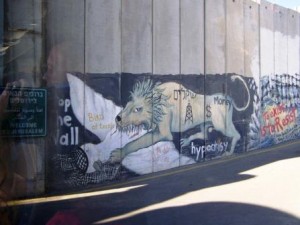The House of Bread. Something about it invokes a thousand memories of home. Millions of Christmas cookies, nativities, concerts, cold evenings by blazing fires, Luke reenactments, snowball fights, temporary lulls in violence and conflict around the world and communities that somehow seem more at peace. There is no way any location on earth could live up to the psychological expectation built into my concept of Bethlehem.
Now if you strip away the million traditional beliefs of Christmas and think rationally about the Judean town you get closer to the truth. When you further consider that it is behind the West Bank wall you get even closer.
Modern day Bethlehem is now one of the most significant cities in the West Bank. It is large, has a university and the buildings fill the hills. Like the other holy sites in the Holy Land the historical sites are all caped by large ancient churches. We are lucky in this sense that it is just Christian churches as we care a lot more about this place then the other two religions do. One cool thing is that the church of the Nativity is one of the oldest churches in the Holy Land. It predates the Dome of the Rock by some 300 years and beats the Holy Sepulcher because it wasn’t destroyed as many times. The stable, cave, is under the apse of the large cathedral. Everything inside is covered in tapestries and marble. It has that dark, smoky, dirty atmosphere that most of the Orthodox/Catholic churches have by virtue of their age. It was actually pretty big inside though the fact is disguised because the cave is split by a wall to form two portions. The other portion, where the manger and birth did not take place, is accessed around the corner in another church. It is much less ornate and there we were able to gather and sing a few songs.
In that same cave is where St Jerome translated the bible into Latin. I wonder if his experience was somewhat similar to that of James E Talmage writing Jesus the Christ in the upper rooms of the temple.
Half of the time we spent there was spent discussing the problems of Palestine. We visited the university and a think tank both of which exist in response to the disintegration of the region. We had to pass through the wall to get there. It seems so much like Berlin. And yet, somewhere inside of me I cannot escape that it is very different. Talking to the Palestinian students at Bethlehem University (funded by the pope but only 1/3 christian and 2/3 Muslim, its interesting that they get along just fine. No Jews) we could tell they were not completely innocent. Of the five students there none of them had Israeli friends, even the ones who lived in Jerusalem and traveled to Bethlehem only for school. They had friends in California and New York and Europe but none in Israel. When they visit Jerusalem they only speak English to avoid being identified easily as Palestinians.
How sad that a place so focused on the peace of the Savior should be the center of such conflict. Jerusalem has been bloodied by war and sacrifice for centuries and even the ultimate human suffering occurred there. Bethlehem was about life and innocence. I suppose it was also the site of the death of the infants and has had it’s share of suffering through the ages. Nevertheless its a place of sobering realities surrounding a spot of infinite peace.




Recent Comments